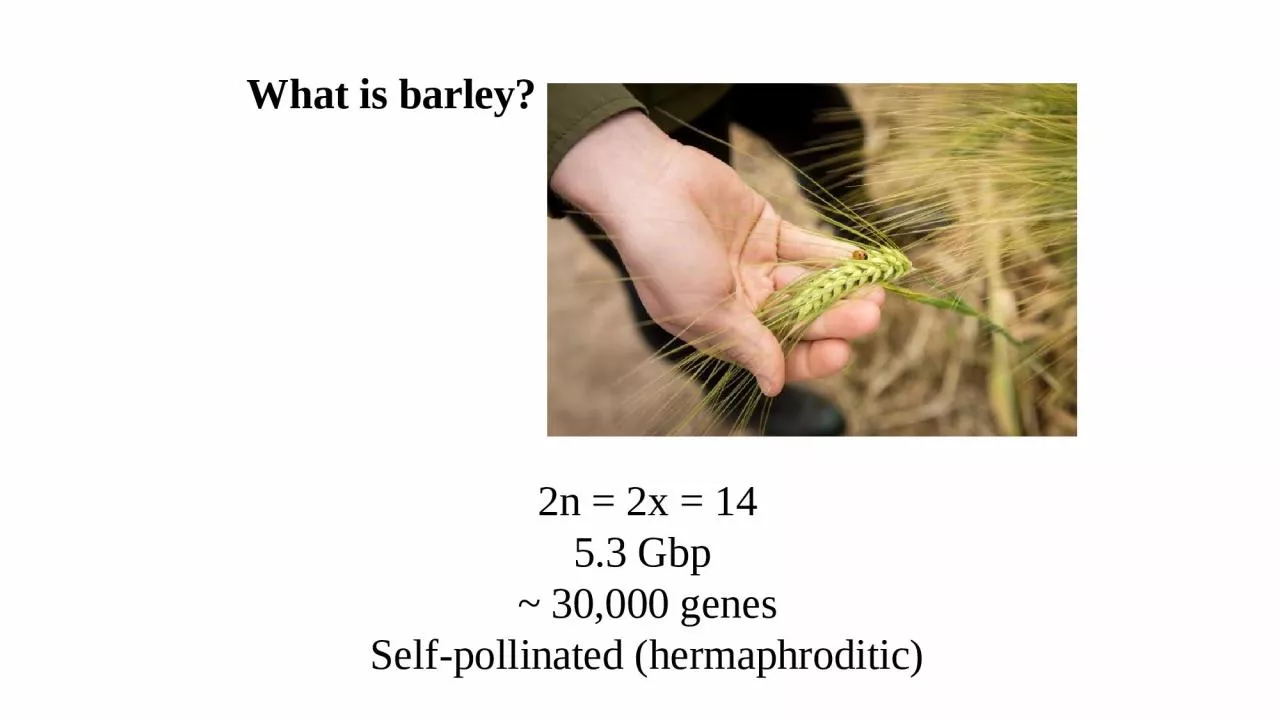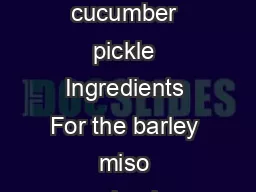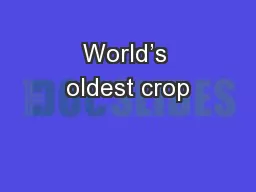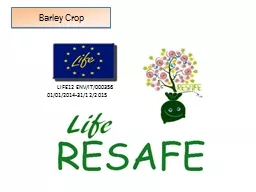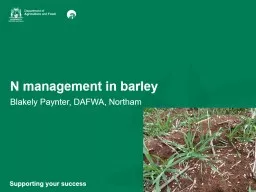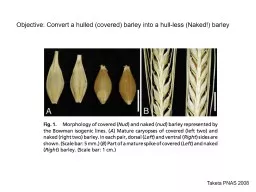PPT-What is barley? 2n = 2x = 14
Author : sophie | Published Date : 2022-06-18
53 Gbp 30000 genes Selfpollinated hermaphroditic Inflorescence type 2row vs 6row 1 gene30000 genes Covered vs Naked 1 gene30000 genes Growth Habit Winter facultative
Presentation Embed Code
Download Presentation
Download Presentation The PPT/PDF document "What is barley? 2n = 2x = 14" is the property of its rightful owner. Permission is granted to download and print the materials on this website for personal, non-commercial use only, and to display it on your personal computer provided you do not modify the materials and that you retain all copyright notices contained in the materials. By downloading content from our website, you accept the terms of this agreement.
What is barley? 2n = 2x = 14: Transcript
53 Gbp 30000 genes Selfpollinated hermaphroditic Inflorescence type 2row vs 6row 1 gene30000 genes Covered vs Naked 1 gene30000 genes Growth Habit Winter facultative and spring. S Barley is the worlds oldest grain as evidenced by discoveries in ancient cities in the Mideast and North Africa It has been cultivate d for about 8000 years and today is the worlds fourth largest cereal crop Ba rley as a food is most commonly ident coukfood Veal cutlet marinated in barley miso ginger and yuzu with burnt chili cucumber pickle Ingredients For the barley miso marinade 3 tbsp barley miso 3 tbsp finely chopped fresh root ginger 3 tbsp finely diced y Native to Middle East. Ancestral form is . winter habit . 2-row . hulled . The ancestral state. 2-row vs. 6-row. 1 gene/30,000 genes. Winter . vs.. Spring. . What is the difference between winter and spring barley, and what the *%^&(+ is a facultative barley? . The first plant protein . with the nutritional quality and potential volume to effectively replace fishmeal in aquaculture feeds . Barley Protein Concentrate. MMP . developed biological . fractionation process, . Update. Barley Supply & Demand Table. . U.S.. Barley. 2010/2011(Est.). 2011/2012(Feb). 2011/2012(Mar). Planted A.. 2.87. . Mill. A.. 2.56 Mill. A.. 2.56 Mill. A.. Harvested A.. 2.47 Mill. A.. 2.24 Mill. A.. . Crop. LIFE12 ENV/IT/000356. 01/01/2014-31/12/2015. Barley. . Crop. Photo. 1. . Barley. . crop. 30/03/2015. Barley. . Crop. Photo. 2. . Barley. . crop. 30/03/2015. Barley. . Crop. Photo. success. Blakely Paynter, DAFWA, Northam. N management in barley. Supporting your success. Key Messages. Supporting your success. Why do the research?. Lodging risk. Source: Blakely Paynter, and Raj Malik DAFWA (14NO26). Hordeum. . spontaneum. Now . there is . …...... : . Hordeum. . vulgare. * . 2n = 2x = 14. 5.3 . Gbp. . ~ 30,000 genes. Self-pollinated (hermaphroditic). * Technically speaking . spontaneum . IAMZ 2015 . Patrick Hayes. Dept. Crop and Soil Science. Oregon State University. Corvallis, Oregon USA. www.barleyworld.org. Class Outline. General considerations for molecular breeding. Selection tools and molecular breeding . ABSTRACT: . Barley is . among the major . food . security . crops . in the highlands and . industrial commodity . for the emerging brewery industry. This paper documents the current productivity levels, varietal adoption and seed commercial . Global and local considerations. Why (Barley). How (Malting). Who (Barley Research, Production and Processing). What’s next (naked barley). Random bits of science and technology. Tap Talk # 1 . Why (Barley). YAVA Sridhar Reddy 1. PG Scholar, Dept of PG studies in Ayurveda Siddhanta, GAMC 2. PG Scholar, Dept of PG studies in Ayurveda Siddhanta, GAMC Mysore, Karnataka, India. 3. Lecturer, Dept of PG stu Taketa PNAS 2008. Hulled phenotype controlled by one gene: NUD. >NUD_CDS. ATGGTACAGTCCAAGAAGAAGTTTCGCGGCGTCAGGCAGCGCCACTGGGGCTCCTGGGTCTCCGAGATCAGGCATCCTCTCCTAAGAGGAGGGTGTGGTTGGGCACCTTTGAGACGGCGGAGGAGGCTGCGCGGGCGTACGATGAGGCTGCCATCCTGATGAGCGGGCGCAACGCCAAGACCAACTTCCCCGTACCGAGGAGTGCCAACGGGGAGATCATCGTCGCCCCAGCAGCAGCAGCACGGGACATTCGCGGTGGCGTTGGCTCGTCGTCCTCCGGGGCCGCCGGCGCCAGCAGCCTGTCACAGATCCTCAGCGCCAAGCTCCGCAAGTGCTGCAAGACACCGTCCCCGTCCCTCACCTGCCTCCGCCTCGACACCGAGAAGTCCCACATTGGCGTCTGGCAGAAGCGCGCGGGTGCCCGTGCCGACTCCAGCTGGGTCATGACCGTCGAGCTCAACAAGGAGCCGGCCGCAGCGGCACCACCAACGCCCAGCGACAGCACGGTGTCGGCGACTCCTTCCTCGTCCACGTCCACGTCCACAACGGGCTCCCCACCGGAGGCAATGGAGGACGAAGAGAGGATCGCGCTGCAGATGATAGAGGAGCTGCTGAGCAGGAGCAGCCCGGCTTCGCCGTCACATGGGCTGCTGCACGGTGAAGAAGGCAGCCTCCTCATCTGA. :. farming barley in . the UK. ;. the process of malting;. barley . in our . diet;. f. ood and drink made from barley and malt.. Farming barley. Barley is grown on about 1.2 million hectares of land in the UK. .
Download Document
Here is the link to download the presentation.
"What is barley? 2n = 2x = 14"The content belongs to its owner. You may download and print it for personal use, without modification, and keep all copyright notices. By downloading, you agree to these terms.
Related Documents

